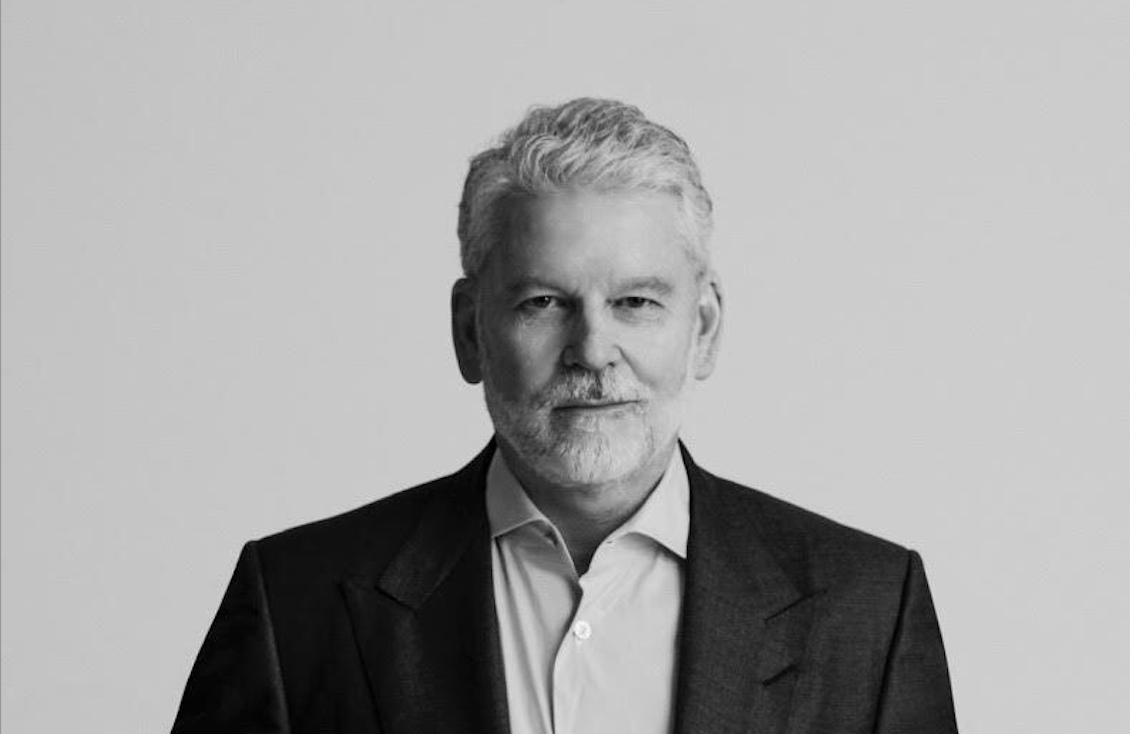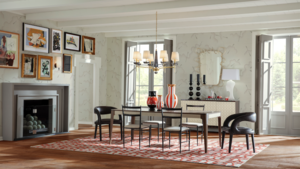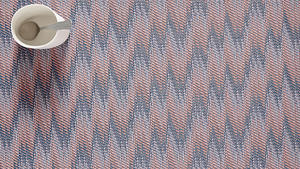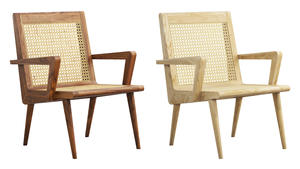Adam Sandow tends to traffic in big ideas and grand gestures. Funny then that his sampling platform Material Bank’s most recent move was a quiet one. Last November, without much fanfare, the entrepreneur—who founded Sandow Media group in addition to Material Bank—stepped back from running day-to-day operations at the unicorn startup, which was last valued at $1.9 billion. He remains chairman of the board, but there’s a new CEO at helm: Sebastian Gunningham.
It’s hard to think of a design industry CEO with a more stacked resume than Gunningham—his CV is chock-full of blue-chip names like Apple and Oracle. His most recent gig, co-CEO of WeWork, was preceded by an 11-year stint at Amazon, where he was on the famed “S-team,” a senior leadership group tasked with high-level strategic decisions at the e-commerce behemoth.
In other words: Gunningham brings considerable prestige to the role. Business of Home spoke with him about what’s next for Material Bank, how the company’s recent launches in Europe and Japan are going, what role the residential side of the design industry might play, and what inspiration he is (and isn’t) taking from the Amazon playbook.
What interested you in Material Bank?
There are a lot of unicorns out there, [but] there are four things that I thought were kind of unique. Number one is I looked around and the customers seem to love this product. With Apple, Amazon and WeWork, I was always after products that I knew customers loved. [The most important thing] is that you are fixing a problem, and [Material Bank is] fixing a problem. I think there are many surrounding problems that can be fixed as an opportunity, and customers seem to really value the service. Number two is that the unit economics of the business work. There are many, many businesses out there that are quite challenged [in that regard]. They have great ideas—but this is a great idea that has enough value that you could charge for it.
The third bucket is that the business has a moat, and that’s mostly driven by Adam and all the industry connections that he had when he started this. There will be competitors—there’s too much opportunity not to. But it’ll be hard to get to the point where we’ve gotten easily. I was looking for a business where the moat is good enough to give you a shot at staying two or three years ahead of the competition.
And number four is, I do think that the market is quite big if you get it right. You’re always looking for businesses where, if you win, the prize is big enough—it’s kind of frustrating sometimes to participate in businesses where you have this great product, customers love you, but the market is constrained. I think that this market can be quite big. The sampling market on its own is probably not enormous. But we’ve just launched the Fulfillment by Material Bank service where we’re offering fulfillment services to any brand, for their stores, their sales reps or their websites—we have the infrastructure to do that. So, you can get into the fulfillment business, you can get into the digital business. I think it can be quite a large market.
Can we get a quick state-of-play for Material Bank? I remember a few years ago the company crossed over 100,000 users. Where are you at now?
The real driver of this business is projects, right? That’s what generates leads. You have this interesting dependency: If I told you that this morning, 1,000 projects were launched in the U.S., 1,000 times more sampling is going to happen on Material Bank. On the member side, we’ve crossed 100,000, and we’ve continued to grow. Members come back based on how many projects they do. Sometimes they disappear for six months and they come back whenever they have a new project—while some are back every day. So, you have a very interesting dynamic. You don’t really ever lose your members, but you do depend on the ebb and flow of projects.
There are also a lot of corporate projects. We have a large percentage of the Fortune 100 companies that are now going directly to Material Bank. And on the brand side, there’s the small, medium and big brands. Big brands are coming to the platform one by one steadily as they get comfortable with the model. The smaller brands come onto the platform a lot—there’s quite a lot of churn. Well, I wouldn’t say it’s churn, but you know, it’s an up-and-down bracket for the small brands, especially in Europe, where there are a lot of brands.
[But] I’ve looked at all the indicators and I think we see very healthy growth on both sides of this marketplace.
What’s the clearest path for growth right now: expanding the core sampling business to more people, or getting into new lines of business?
One I know [the answer to], and one I don’t. I know that the core sampling business has a lot of growth ahead. Whether you look at geographic growth or category growth, we’re still not in all the sampling categories, so if you were looking at us as an investor, I’d say, that’s a hopefully fairly predictable growth path: more brands, more members, more projects. And there are regions that we’re not in yet.
All the auxiliary things, we think there’s a lot. But you need to prove them. As Adam has hinted in the past, we have a very exciting consumer offering coming. We think it’s a very big opportunity. But we’ll see when we get up and running.
We launched our fulfillment service three weeks ago, and we’ve signed up more than five brands already. We have no lack of ideas for how to help out both our brands and our members. So to answer your question, if I put on my super optimistic hat, I’d say that [expanded lines of business are] as big or bigger than our current business as far as the opportunities go. If I put my pessimistic hat on, I don’t quite know. But we’re sure going to go after them all, and we’ll see.
If you look at the consumer launch, we already have many of the brands telling us: “Please have a consumer offering! I already have my SKUs inside your fulfillment center, just light it up for the consumer.” So there are a lot of pieces that overlap quite well. The broad answer is we think there’s a lot of opportunity on both the mothership and some of the ideas that we have going forward. We have a long list of ideas and products to build that we think are going to have a lot of impact.
Can you walk me through the fulfillment concept a little bit?
We have an infrastructure where if you order a [sample] on Material Bank, we deliver it to you overnight as a designer or an architect—that’s the basic model. But there are samples being delivered in many places from many channels. So whether you go to a brand’s website, or a brand’s store, or a brand’s sales reps … There are thousands of sales reps out there traveling with materials in their cars and storage. So we just are standing on the shoulders of the infrastructure we have. If you want to start up a business, and you need sampling, then we say, “Give us all your product sampling, send us the order, wherever it comes from, and we’ll do the shipping for you.”
So it’s taking the Material Bank infrastructure, but not requiring brands to be on the Material Bank platform. Like a white-label sample fulfillment service.
It’s basically a logistics service, which is a flywheel for us. The more stuff we get into our hub, the more stuff that we could potentially light up on our own website, and also we’re providing services for others. That’s what Fulfillment by Material Bank is.
Historically, some residential fabric brands have told me they like the idea of Material Bank, but their samples are expensive to produce, so the unit economics don’t work as well, and also they want to control the experience. Do you see the residential side of the industry as a growth area?
In our current model, the architect and designer do not pay, which means it’s “free” and the brand is paying us for the value of that piece of information. We haven’t decided on this entirely yet, but on the residential side, the consumer will be paying. So if you’re renovating your house and you want a sample of a carpet, you will pay—if I was on Williams-Sonoma’s site, I think it’s $5 or $10. There’s a version of that.
I don’t think the current value of the lead or the price you can charge in the commercial world will be the same in the residential world. We’re going to learn our way into this. Because, you’re right: You could overwhelm a textile company with a bunch of samples all day long. It’s expensive, the samples cost them money, and the lead may not be that valuable—[the user] may not actually be ready to renovate their house.
There are a lot of use cases. So we’re going to carefully figure out where the value is that we can charge on both sides of the marketplace. It varies by category. I think textiles seem to be much more challenging than some of the other categories. But we’ll go piece by piece. Paint is a little bit easier, because it’s much cheaper to produce a paint sample. We have [paint sampling business] Samplize, and it’s less costly to ship. It’s not a one-size-fits-all.
I’m curious specifically about residential designers—do you see there being a different approach there?
We do hear feedback that says, “Well, hold on. The designer for residential does want a different space from where the consumer is going to be.” We’ve heard a bit of that. We’re going to think about how best to satisfy both ends of this.
Any insight into how Material Bank’s expansion into the European and Japanese markets is going?
It’s very early days in Japan. The data shows that it’s a large market, from a numbers perspective—it’s almost as big as the U.S. in terms of designers and architects. The signals are that they love the product, and we’re in the process of acquiring brands. The process in Japan has different speeds on each side of the marketplace. We’re happy so far; we have a very good partnership in Japan. We love the team, we’re sharing all the technology, [but it’s] very early days. I can’t declare victory or failure yet, but we’re excited. This is not an industry that moves at high velocities with these things. So far, so good.
I think it’s quite the opposite of high velocity. That’s one of the biggest challenges for anyone trying to do anything with technology in the industry—a sort of cultural resistance to the pace of tech.
Well, it’s slow until it’s not, right? I lived that trajectory at Amazon. [There] it was category by category. The booksellers were very slow until it moved violently fast. The same goes for electronics, but apparel was different. There were some categories that were very forward leaning with how they adopted technology and how they went to different distribution models. High-end luxury, for example—they’re still not going to websites, they’re not going on to marketplaces. They’re still holding their stores. It’s all over the map. But my white hair tells me that it’s very, very slow—until it’s not. And then, you better be ready. And it’s not just about Material Bank. It’s just the future. The future catches up with you.
Right before we started talking, I was looking at the site, ballparking how many brands are on the platform. I think there are 600 or 700 on the U.S. site. That’s not an order of magnitude more than there were a few years ago. Do you think at some point there’s going to be this rapid acceleration where suddenly: There are 3,000 brands on this platform! Do you expect that?
You know, I don’t. Adam will probably have a better instinct on this. But my view is: This is steady, because the brands have their [own] distribution models. I think that we’ll see a steady growth in brands. I think on the lower end, there’ll be a very rapid acceleration, because this is a great distribution model for them. It’s a no-brainer to come in. On the high end, with the brands that are the most important, the biggest, the most sophisticated, it’ll be a steady adoption. They see the value; they move cautiously.
I wish I could say I [expect] to see what I saw at Amazon. I don’t think that’s going to be it, personally. By the way, ask me the same question a year from now; I may be completely wrong. But I think this is steady—prove your value, make sure that you’re satisfying both sides of the equation. We’ll keep growing our assortment and our SKUs and our brands consistently. I think that’s the way it’s going to play out.
To keep going with the Amazon analogy … Two things Material Bank could do are: Manufacture your own product in some form, as Amazon has done with Basics. And make money, as Amazon has done so successfully, on advertising. I’ve asked this question to Adam, and he’s always been adamant that Material Bank wasn’t going down those roads, so I’m guessing you have the same answer. But I’m curious, especially about advertising—do you see that as an area to increase revenue?
Honestly, Amazon wasn’t a great business for making your own stuff. The reason that Amazon did it [was] as a loss leader to acquire [customers], to always compete at a low price. So it’s a different objective. And, you know, a bit of the Amazon DNA was, if you walked into a meeting and there was no pencil on the table, it was “Let’s go build a pencil.” That is a company that’s always trying to build stuff.
[But] for a few successes on things like batteries and some of the staples that you buy, there were a lot of failures in that world. And it was very costly, because you lose trust with some of the brands. I think you probably see [in some categories] that Amazon has stayed in there [producing its own products], but for [Material Bank], I think it would be a terrible idea. Honestly, it’s not even a mediocre idea—it’s a terrible idea.
On the advertising question, we’ll see. The advertising on all these marketplaces is: You’re paying for placement. There’s a huge tension between you going to Google and saying, “I see these three first results that are paid, versus all the rest of the results.” And the question is, which ones do you really trust? At Amazon, it was a huge fight. Half the table was like, “For sure, this is such easy money—when you search for a TV, the first three results are sponsored.” Versus the other half of the table that says, “Well, that’s not customer choice, purely data-driven; we should just show the TVs with the best reviews and the best sales.” And that fight is going to go on for another 100 years on all marketplaces.
Material Bank is very pure in how we rank our products. And whether we would open the platform up for people to pay for placements is a big decision. Personally, I don’t think we have the traffic to do that yet. These things require a lot of traffic. Say you have 200,000 members: How many of them are on the site every day? There are some pros and cons. I’m at the middle of the table, but very skeptical about ad-driven models on the site. I like ranking and relevance and similarities and [personalized] recommendations based on the true data of your behaviors.
And the other thing in this industry that I’d be very cautious about is that the big guys win. If you’ve got a big brand and a profit pool, you can pay for advertising in addition to what you’re paying for a lead—then it becomes a little bit unbalanced. The rich people get richer, the poor people have to fight a different battle. I’m not saying no. Personally, it’s not on my radar at least for another year or two. And even then, I want to take a really, really close look at this and see if it makes sense for the members and the brand.





























